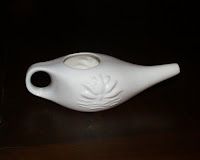Three popular oils which are used in ayurvedic massage are olive, sesame and sunflower oil as these are all very nutritious oils and help aid the detoxification process when used on the skin in massage. The book goes on to say:
“Different oils are recommended for the different dosha types. For example, the best oil to use for vata type is good quality, cold-pressed sesame oil, which strengthens the skin and protects it from fungal infections and the harmful effects of the sun. If you find that this irritates your skin, use olive oil or sweet almond oil instead. Clarified butter (ghee) can also be used. Always heat the oil to body temperature before using it. Many more oils can be used, but the recommendations below are a good selection for your daily massage.From my understanding of Ayurveda, the belief is that we are comprised of three vital energies which are called doshas – vata, pitta, and kapha. Everyone consists of all three doshas but to varying degrees and tend to have maybe one or two dominant doshas.
Vata types – Choose calming oils, including sesame, olive, almond, wheatgerm, and castor oil.
Pitta types – Choose cooling oils, such as coconut, sandalwood, pumpkin seed, almond, and sunflower seed.
Kapha types – Choose burning oils. These include mustard, corn, and safflower.”
“Our dosha determines our constitution, preferences, personality traits, sleeping patterns, and even the foods we should eat.”When our doshas become unbalanced as we go through life due to stress, environment, diet etc we become ill.
You can find out what dosha you are and more about them by taking a quiz. My dosha turned out to be vata.
So by using the right carrier oil to suit your dosha can help to keep you in balance according to Ayurvedic philosophy.

![Reblog this post [with Zemanta]](http://img.zemanta.com/reblog_e.png?x-id=559a102b-7951-409e-a757-86c7f54ac08a)

![Reblog this post [with Zemanta]](http://img.zemanta.com/reblog_e.png?x-id=73506edc-68ea-442d-89f8-491c96ffbe58)

![Reblog this post [with Zemanta]](http://img.zemanta.com/reblog_e.png?x-id=265dd21b-a6a6-48ff-9f43-8a441f9aa354)

![Reblog this post [with Zemanta]](http://img.zemanta.com/reblog_e.png?x-id=32a7c33e-c5e8-4684-80f3-10c20ca5075a)
![Reblog this post [with Zemanta]](http://img.zemanta.com/reblog_e.png?x-id=279a6816-16b5-400d-abc2-3689a807e3f7)
![Reblog this post [with Zemanta]](http://img.zemanta.com/reblog_e.png?x-id=0f179723-1200-4d9a-a383-6c48b7208ca5)

![Reblog this post [with Zemanta]](http://img.zemanta.com/reblog_e.png?x-id=ae38cbaa-10f6-47a0-8d70-90a3a9ac2a21)

![Reblog this post [with Zemanta]](http://img.zemanta.com/reblog_e.png?x-id=3f82720d-b5f6-4d1d-af49-cca2fc8d2af1)





